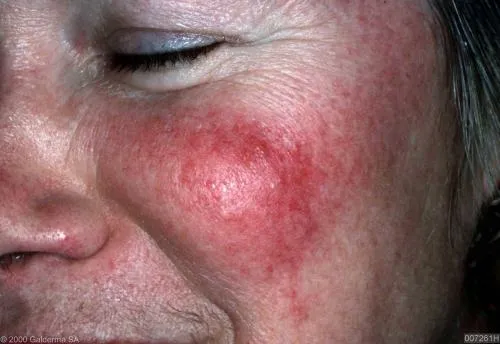Rosacea is a chronic, inflammatoryskincondition that is often mistaken as adult acne, eczema, sunburn, or askinallergy. Rosacea is common among those older than thirty years, although there is no known cause or even cure for the condition. Luckily, however, there are many way to make the symptoms of this condition easier to live with. This may include medication, lifestyle changes, or medical procedures depending on the severity of a person’s condition.
Rosacea affectsover sixteen million peoplein the United States and seems to most commonly occur in those that are fair skinned. However the estimated amount of people this condition affects could be much larger considering that it is commonly misdiagnosed and therefore often not recorded.
What are the Symptoms of Rosacea?
The symptoms of Rosacea vary from person to person, but there are many general ones that seem to cover the whole of the condition.
- Flushing(also referred to as “blushing”). The flush may spread throughout the face and down to the neck and chest and cause theskinto feel hot. A flush can last several minutes.
- Facialskinsensitivity. Blood vessels become more sensitive and can react poorly to touch, sunlight, or other physical stimuli. This is often mistaken for having sensitiveskin, whereas sensitiveskinis caused by sensitiveskincells rather than sensitive blood vessels.
- Rhinophyma. One symptom of Rosacea includes rhinophyma which is defined as a large, red, bulbous or bumpy nose.
There are also three different types of Rosacea which include different symptoms depending on which type a person is affected with.
- Inflammatory Rosacea. This type is recognized by many small pimples, papules and pustules around the face. This often happens around the nose and is misdiagnosed as acne.
- Vascular Rosacea. Blood vessels in the face may swell, causing blotchyskinaround the nose and cheeks. This is also called telangiectasia.
- Ocular Rosacea. As the name suggests, this type affects the eyes. Symptoms include burning or itchy eyes. This can cause blepharitis, which is defined as inflammation under the eyelids, and conjunctivitis, also known as pink eye.
What Causes Rosacea?
The cause of Rosacea iscurrently unknown, however there are some things that are thought to trigger it or make it worse once affected. Dermatologists believe abnormalities in the blood vessels could cause many of the symptoms associated with Rosacea, but the cause of those is still unknown. Other symptoms include fairskinand genetics, although these are not definitive.
There is also a bacteria found in the gut calledH. pylorithat assists in the creation of a protein called bradykinin. This protein causes blood vessels to dilate which leads scientists to believe that this could contribute to either the cause or symptoms of Rosacea. However, nothing is set in stone and this is simply a theory.
Another possible cause is the microscopic mite known asDemodex folliculorum. This mite is a part of our everyday normal life as it lives on ourskin. Although it does not cause any harm in usual cases, it has been found that those who suffer from Rosacea have large amounts ofDemodex folliculorum. However, this correlation does not necessarily show causation, and scientists do not know which is the cause of the other.
How is Rosacea Treated?
Rosacea has no known cure, only treatments that can ease the condition’s symptoms. Doctors may prescribe medications or lifestyle changes to make things easier for a patient who suffers from Rosacea. More often than not, a prescribed treatment will include both types.
Lifestyle changes will usually mean removing certain triggers that could make Rosacea symptoms worse. These triggers include spicy foods and drinks, caffeine, dairy, extreme weather circumstances, stress, intense exercise, hot baths, saunas, alcohol, and some medications that treat high blood pressure. These triggers do not necessarily make symptoms worse for every person affected by Rosacea. Therefore, a doctor might need to use trial and error in order to help a patient figure out what things to eliminate from his or her lifestyle.
Some medications a doctor might prescribe include topical medicines such as antibiotics to reduce redness and inflammation, antibiotic pills for inflammation, or a steroid eye drop called Blephamide for those who suffer from ocular Rosacea. There are other types of oral medications andspecialized cosmetic treatmentsa doctor might prescribe depending on the kind of Rosacea a person suffers from.
Other than medication and lifestyle changes, there are also some procedures that may help. A dermatologist can perform a laser treatment of intense pulsed light to make visible blood vessels smaller. A plastic surgeon may also be involved for those with rhinophyma to remove the excess tissue and thick bumps. These procedures may cause pain and other immediate side effects, but these usually subside within a few weeks after the procedure.
